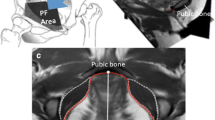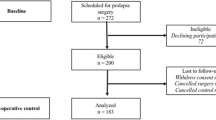Abstract
Transabdominal ultrasound was used to assess 104 women with incontinence and prolapse. The bladder was used as a marker of levator plate (LP) movement. The women were asked to draw in and lift the pelvic floor muscles (PFM) and a change in position of the LP in a cranial or caudal direction during contraction was documented. Three different patterns of movement of the LP were identified, with 38% of subjects elevating and 43% of subjects depressing the LP; 19% had no change in LP movement. In the stress incontinence group there was a higher than expected number that elevated the LP. In the urgency and prolapse groups there was a higher than expected number of subjects that depressed the LP (P=0.008).The results highlight three different subgroups based on the patients' attempt to initiate elevation of the LP. Subjects who depressed the LP when instructed to elevate it appeared to adopt straining strategies via the generation of intra-abdominal pressure. Depression of the LP may have long-term negative implications for prolapse and incontinence.


Similar content being viewed by others
Abbreviations
- LP:
-
levator plate
- PFM:
-
pelvic floor muscles
- MRI:
-
magnetic resonance imaging
References
Bo K, Talseth T, Holme I (1999) Single blind randomised control trial of pelvic floor exercises, electrical stimulation, vaginal cones and no treatment in the management of genuine stress incontinence in women. Br J Med 318:487–493
DeLancey J (1988) Anatomy and mechanics of structures around the vesical neck: how vesical neck position might affect its closure. Neurourol Urodyn 7:161–295
Kegel A (1948) Progressive resistance exercises in the functional restoration of the perineal muscles. Am J Obstet Gynecol 56:238–249
Dietz H, Wilson P (1998) Anatomical assessment of the bladder outlet and proximal urethra using ultrasound and video-cystourethrography. Int Urogynecol J 9:365–369
Christensen L, Djurhuus J, Constantinou C (1995) Imaging pelvic floor contractions using MRI. Neurourol Urodyn 14:209–216
Bo K, Lilleas F, Talseth T, Hedland H (2001) Dynamic MRI of the pelvic floor muscles in upright sitting. Neurourol Urodyn 20:167–174
Bump R, Hurt WG, Fantl JA, Wyman JF (1991) Assessment of Kegel pelvic muscle exercise performance after brief verbal instruction. Am J Obstet Gynecol 165:322–329
Theofrastous J, Wyman JF, Bump RC, McClish DK, Elser DM, Robinson D, Fantl JA (1997) Relationship between urethral and vaginal pressures during pelvic muscle contraction. Neurourol Urodyn 16:553–558
Van Loenen N, Vierhout M (1997) Augmentation of urethral pressure profile by voluntary pelvic floor contraction. Int Urogynecol J 8:284–287
Bo K, Finckenhagen H (2001) Vaginal palpation of pelvic floor muscle strength: inter-test reproducibility and comparison between palpation and vaginal squeeze pressure. Acta Obstet Gynecol Scand 80:883–887
Bo K, Stein R (1994) Needle EMG registration of striated urethral wall and pelvic floor muscle activity patterns during cough, Valsalva, abdominal, hip adductor and gluteal muscle contractions in nulliparous healthy females. Neurourol Urodyn 13:35–41
Laycock J (1995) Pelvic floor dysfunction. Bradford: University of Bradford
Dietz H, Wilson P, Clarke B (2001) The use of perineal ultrasound to quantify levator activity and teach pelvic floor muscle exercises. Int Urogynecol J 12:166–169
Peschers U, Gingelmaier A, Jundt K, Leib B, Dimpfl T (2001) Evaluation of pelvic floor muscle strength using four different techniques. Int Urogynecol J 12:27–30
Peschers U, Schaer GN, DeLancey JO, Schuessler B (1997) Levator ani function before and after childbirth. Br J Obstet Gynaecol 104:1004–1006
Peschers U, Schaer G, Anthuber C, Delancey JO, Schuessler B (1996) Changes in vesical neck mobility following vaginal delivery. Obstet Gynecol 88:1001–1006
Schaer G et al. (1995) Simultaneous perineal ultrasound and urodynamic assessment of female urinary incontinence. Int Urogynecol J 6:168–174
Sampselle C, Brink C, Wells T (1989) Digital measurement of pelvic muscle strength in childbearing women. Nurse Res 38:134–138
Murphy C, Sherburn M, Allen T (2002) Investigation of transabdominal diagnostic ultrasound as a clinical tool and outcome measure in the conservative measurement of pelvic flor muscle dysfunction. Proc Int Continence Soc Meeting, Heidelberg. Abstract 129:61
O'Sullivan P, Beales DJ, Beetham JA, Cripps J, Graf F, Lin IB, Tucker B, Avery A (2002) Altered motor control strategies in subjects with sacroiliac joint pain during the active straight-leg-raise test. Spine 27:E1–E8
Avery A, O'Sullivan P, MacCallum M (2000) Evidence of pelvic floor muscle dysfunction in subjects with chronic sacro-iliac joint pain syndrome. Proceedings of the 7th Scientific Conference of the IFOMT
Miller J, Aston-Miller J, DeLancey J (1996) The Knack: use of precisely timed pelvic muscle contraction can reduce leakage in SUI. Neurourol Urodyn 15:392–393
Neumann P, Gill V (2002) Pelvic floor and abdominal muscle interaction: EMG activity and intra-abdominal pressure. Int Urogynecol J 13:125–132
Benvenuti F, Caputo GM, Bandinelli S, Mayer F, Biagini C, Sommavilla A (1987) Reeducative treatment of female genuine stress incontinence. Am J Phys Med 66:155–168
Bo K, Oseid S, Kuarstein B et al. (1988) Knowledge about and ability to correct pelvic floor muscle exercises in women with urinary stress incontinence. Neurourol Urodyn 7:261–262
DeLancey J (1993) Anatomy and biomechanics of genital prolapse. Clin Obstet Gynecol 36:897–909
Author information
Authors and Affiliations
Corresponding author
Additional information
Editorial Comment: These authors present a descriptive analysis of patients with pelvic floor dysfunction who were observed with an abdominal ultrasound while attempting voluntarily to contract their pelvic floor muscles. There seems to have been significant bias when the initial classification of patients was made. It is important to recognize the limitations of this study design. This is a descriptive study, which is only capable of showing statistical associations between groups. No cause and effect relationships among these groups should be assumed. It seems reasonable that transabdominal ultrasound may have an important role when assessing pelvic muscle contractility. Using this technique to teach patients to contract their pelvic floor effectively would be an interesting application. Further research in this area will be welcomed.
Rights and permissions
About this article
Cite this article
Thompson, J.A., O'Sullivan, P.B. Levator plate movement during voluntary pelvic floor muscle contraction in subjects with incontinence and prolapse: a cross-sectional study and review. Int Urogynecol J 14, 84–88 (2003). https://doi.org/10.1007/s00192-003-1036-5
Received:
Accepted:
Published:
Issue Date:
DOI: https://doi.org/10.1007/s00192-003-1036-5




